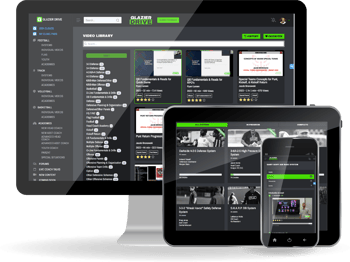FREE Online Flag Football Coaches Clinic
FREE Online Flag Football Coaches Clinic June 20-21
Glazier Clinics, the leader in football...
The sooner the quarterback can get set to throw the more time he will have to look over the field. Therefore, it becomes important for a quarterback to take the ball from the center and move to the position where he is going to set up and throw just as rapidly as he possible can while still maintaining his balance. It is best no matter what the depth of the quarterback's pass set is, use as few steps as possible (avoid the common mistake of taking a false step forward as you pushes back away from the center).
As the quarterback reaches the spot from where he is going to pass from he should stand as erect as possible just prior to making the actual throw. This enables him to get a good view of the field, the pattern of the defense, and the position of his potential receivers. The quarterback's feet should be fairly close together with his weight forward on the balls of his feet, instead of back on the heels, so the quarterback will be in a position to shift his weight properly as he makes his delivery. This also furnishes him with the balance in any direction if it is necessary to set up into the "pocket" of his protection, or to suddenly take of and run if his receivers are covered.
The quarterback should stand with his feet relatively close together because this makes it easier to step forward with his lead foot as he makes his throw. As the quarterback starts to throw, nearly all of his weight should be on his right foot. As a right handed quarterback sets to throw he should take a stride of about 16 inches with his left foot in the direction of the receiver. As the ball leaves the quarterbacks hand, it is helpful if he forms the habit of dragging his near foot forward until it comes almost parallel with the forward foot. This will help the quarterback get a better follow through, which will also put him in a position to react in any direction and dodge any hard charging lineman.
As the quarterback sets to throw, the ball should be held in both hands, level with and a few inches to the side of the right ear. Two hands should be kept on the ball for as long as possible for two important reasons: 1) if the quarterback gets hit from the blind side there is far less chance of a fumble with two hands on the ball than there would be if you pass set with the ball in one hand with the
non-passing arm out in front or down to the side. 2) the quarterback can make a much better fake when passing if he has two hands on the ball. This enables him to draw the ball back and really bring it forward sharply in a passing motion by "pumping" it forward into his non-passing hand, thus, these are key points to remember and emphasize when setting your drills.
Courtesy Coach Jerry Campbell
Glazier Clinics, the leader in football...
FOR IMMEDIATE RELEASE GLAZIER CLINICS ACQUIRES THE RENO CLINIC OF CHAMPIONS
UNLIMITED COACHES - UNLIMITED IN-PERSON & ONLINE EDUCATION
The Glazier Season Pass gives all your coaches access to these resources:

Each clinic has 100+ sessions of practical Xs & Os for your entire staff. Network and brainstorm with some of the best speakers and coaches in the game.
Find a clinic near you
Join over 34,000 coaches on Glazier Drive, with 48 complete football systems, online clinics, 2,000+ videos, and much more.
Learn more about Drive